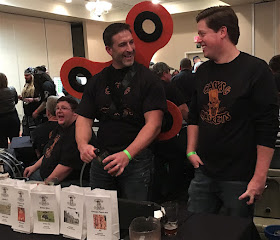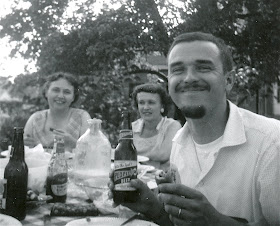The Return of Canned Beer
On February 7, Bare Bones became the first brewery to can its beer in Oshkosh since 1972 (the year Peoples Brewing closed). Bare Bones used a mobile canning unit to package Double Dog Dazed, an 11% IPA. It was also the first time an Oshkosh brewery packaged its beer in 16-ounce cans or sold beer in four packs. Bare Bones had additional canning runs in May and December.
The Opening of Fletch's Local Tap House
Fletch's Local Tap House opened on May 6 at 570 North Main Street. Owner Jeremy West also runs the neighboring Varsity Club. Fletch’s launched with 24 draft lines in a newly remodeled space. The building dates to 1902. With the addition of Fletch's, there are now approximately 200 craft-beer draft lines in the bars along North Main Street between Irving and the river.
 |
| Fletch's Local Tap House |
Juice Cloud
In September, Lion’s Tail Brewing in Neenah released Juice Cloud, a New England Style IPA. It was the first time the style had been produced by a commercial brewery in Winnebago County. Juice Cloud has gone on to become the brewery’s best selling beer.
Historic Fresh-Hop Beers
For the second year in a row, both Bare Bones and Fox River produced fresh-hop beers. Bare Bones' Wharrgarbl was brewed on September 9. All of the hops that went into the beer were Wisconsin grown. This hasn't been done by a brewery in Oshkosh in more than 100 years.
 |
| Bare Bones head brewer RJ Nordlund selecting hops at a Gorst Valley Hop Farm in in Nekoosa, Wisconsin. |
Fox River's Big Ed's Hopyard Ale was brewed on September 13. The bulk of the hops used were grown in a Winnebago County hopyard cultivated by Scott Clark and Steve Sobojinski. This year's harvest included hops raised from cuttings of wild hops growing on the site of a former hopyard established in the late 1840s in Allenville. This site appears to have been the location of Winnebago County's first hop farm. The Fox River beer is the first commercial beer since 1879 to use hops from this lineage.
 |
| Big Ed’s Hopyard |
Production at local breweries has been strong all year. By the end of October, Bare Bones, Fox River, and Lion's Tail had each produced more beer than they had in all of 2016. At Knuth Brewing in Ripon, production has more than doubled. The final numbers aren't in yet, but it appears likely Fox River will unseat Stone Arch this year as the largest brewer in the Fox Valley.
The Return of Casks and Caskets
After a three-year hiatus, Wisconsin’s first and only all-homebrewed beer festival returned to Oshkosh on November 4. Sponsored by the Society of Oshkosh Brewers, Casks and Caskets was suspended after state revenue officials deemed the club’s 2014 festival unlawful. This year, the SOBs staged the festival as a free event to conform to the latest interpretation of Wisconsin’s homebrew law. The $6,000 in donations collected at the festival went to the Oshkosh Hunger Network.
 |
| Casks and Caskets, 2017 |
On November 8, Fifth Ward Brewing Company opened at 1009 South Main Street. It marked the first time since 1956 that three breweries have operated simultaneously in Oshkosh. Co-founded by Ian Wenger and Zach Clark, the brewery had been in planning since 2012. The first beers issued by Fifth Ward were Burl Brown, a brown ale made with cinnamon and molasses, and Hades’ Secret, a porter brewed with chocolate and mint.
 |
| Zach Clark (left) and Ian Wenger, opening day at Fifth Ward Brewing. |
The Opening of the Granary
The Granary Brew Pub opened in early November. The craft-beer bar and restaurant began with 30 Wisconsin-brewed beers on tap. All four Winnebago County breweries were represented. In all likelihood, this was the first time beer from four separate Winnebago County breweries has been served on tap in the same bar.
Onward!
The coming year is bound to be interesting. On the tavern side, I doubt we’ll see the launch of another full-fledged craft beer bar. We may have reached a saturation point there. But on the brewery front, we’ll likely see more development. HighHolder Brewing, which has been threatening to open for months, may finally break through. Let’s hope so. New breweries are also slated for Omro and Menasha. If each comes to fruition in 2018, we’ll have seven breweries in Winnebago County. That hasn’t happened since 1894. The beer scene here is maturing. Room for growth remains. Onward!















































